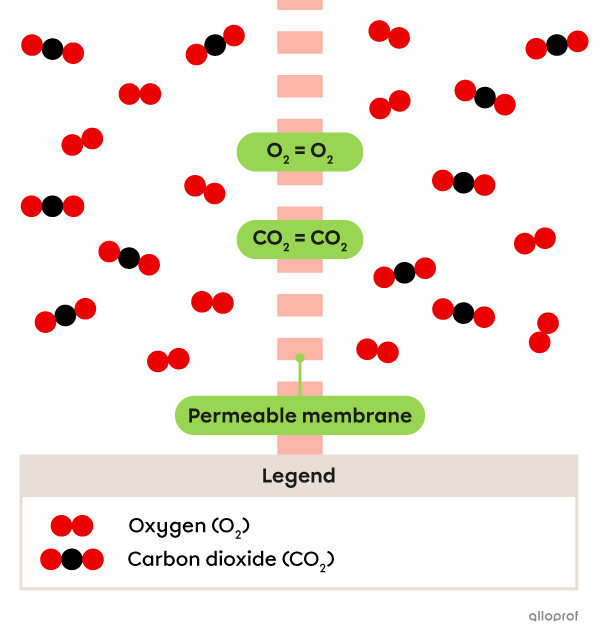The exchange of gases between the air and blood enable the main purpose of the respiratory system, which is to supply the body with oxygen |(\text{O}_2)| and expel carbon dioxide |(\text{CO}_2).|
The structures below are involved in pulmonary gas exchanges.

The following table describes the different structures involved in pulmonary gas exchanges.
| Structure | Description |
|---|---|
| Lungs | The lungs are two spongy and elastic organs. They contain bronchioles and alveoli. Air moves in and out of the lungs through respiratory movements. |
| Bronchioles | The bronchioles are small ducts that enable the air to flow into and out of the alveoli. |
| Alveoli | The alveoli are small bubbles at the ends of the bronchioles with thin walls permeable to gases. Clusters of alveoli are called alveolar sacs. |
| Blood capillaries | Blood capillaries are small vessels surrounding the alveoli with thin walls permeable to gases. In the image above, the red blood capillaries are grouped into venules. They carry blood from the alveoli to the heart. The blue blood capillaries are branches of arterioles. They carry blood from the heart to the alveoli. |
In the air, respiratory gas particles are dissolved. In contrast, in blood, respiratory gas particles are partly dissolved and partly attached to hemoglobin, a protein found in red blood cells.
-
The respiratory gases are oxygen |(\text{O}_2),| an input of cellular respiration, and carbon dioxide |(\text{CO}_2),| an output of cellular respiration.
-
Diffusion is a process of passive transport where particles of a solute tend to move from an area of higher concentration to an area of lower concentration, so that the concentration of both solutions is at equilibrium.
Respiratory gases can pass through the thin walls of the alveoli and blood capillaries. This ability is what makes pulmonary gas exchanges by diffusion possible. Respiratory gases pass from the air in the alveoli to the blood in the blood capillaries, and vice versa depending on their concentration.
The following images represent the diffusion of oxygen |(\text{O}_2)| and carbon dioxide |(\text{CO}_2)| through a permeable membrane. The membrane could correspond to the wall of the alveoli or the wall of the blood capillaries.
The oxygen concentration |(\text{O}_2)| is greater on the right side of the permeable membrane.
The carbon dioxide concentration |(\text{CO}_2)| is greater on the left side of the permeable membrane.

The difference in concentrations on both sides of the membrane causes the system to be unbalanced. To balance the system, the oxygen particles |(\text{O}_2)| tend to move across the membrane to end up on the left side. Similarly, the carbon dioxide particles |(\text{CO}_2)| tend to move across the membrane to end up on the right side.

The oxygen concentration |(\text{O}_2)| is the same on each side of the permeable membrane.
The carbon dioxide concentration |(\text{CO}_2)| is the same on each side of the permeable membrane.

The concentration of respiratory gases varies according to:
-
the rhythm of air flowing into and out of the alveoli (inhalation and exhalation);
-
blood supply to blood capillaries.
The following diagram describes the gas exchanges between the air of an alveolus and the blood of a blood capillary.
A. Air concentrated in oxygen |(\text{O}_2)| reaches the alveoli following an inhalation.
B. Blood concentrated in carbon dioxide |(\text{CO}_2)| reaches the blood capillaries as part of pulmonary circulation.
C. The difference in gas concentration between the air in the alveolus and the blood in the blood capillary initiates the movement of particles from an area of higher concentration to an area of lower concentration. At this stage, oxygen particles |(\text{O}_2)| tend to diffuse into the blood and carbon dioxide particles |(\text{CO}_2)| tend to diffuse into the air.
D. The blood in the blood capillary is now more concentrated in oxygen |(\text{O}_2)| than initially and it is sent to the heart to enter the systemic circulation.
E. The air in the alveoli is now more concentrated in carbon dioxide |(\text{CO}_2)| than initially and it is ready to be exhaled.

This is how gas exchanges occur in the approximately 300 million alveoli contained in the two lungs. The process feeds the billions of cells that make up the human body with oxygen and removes carbon dioxide from them.
Other gas exchanges occur in the body. They take place between the tissue cells and the blood. It is called systemic gas exchanges.
As a result of pulmonary gas exchanges, red blood cells carrying oxygen |(\text{O}_2)| supply the tissues of the body through the blood circulation. For example, the arterioles near the biceps of the arm convey blood to the blood capillaries. Due to a variation in concentration, the |\text{O}_2| diffuses to the muscle cells. Similarly, carbon dioxide |(\text{CO}_2)| produced by the muscle cells diffuses into the blood capillaries.
